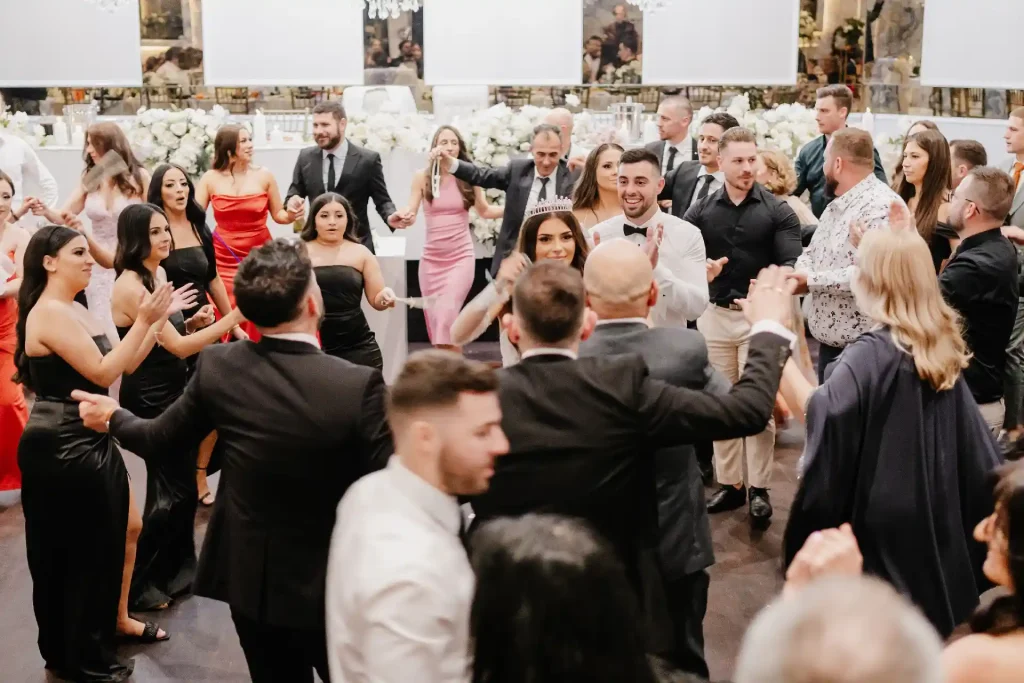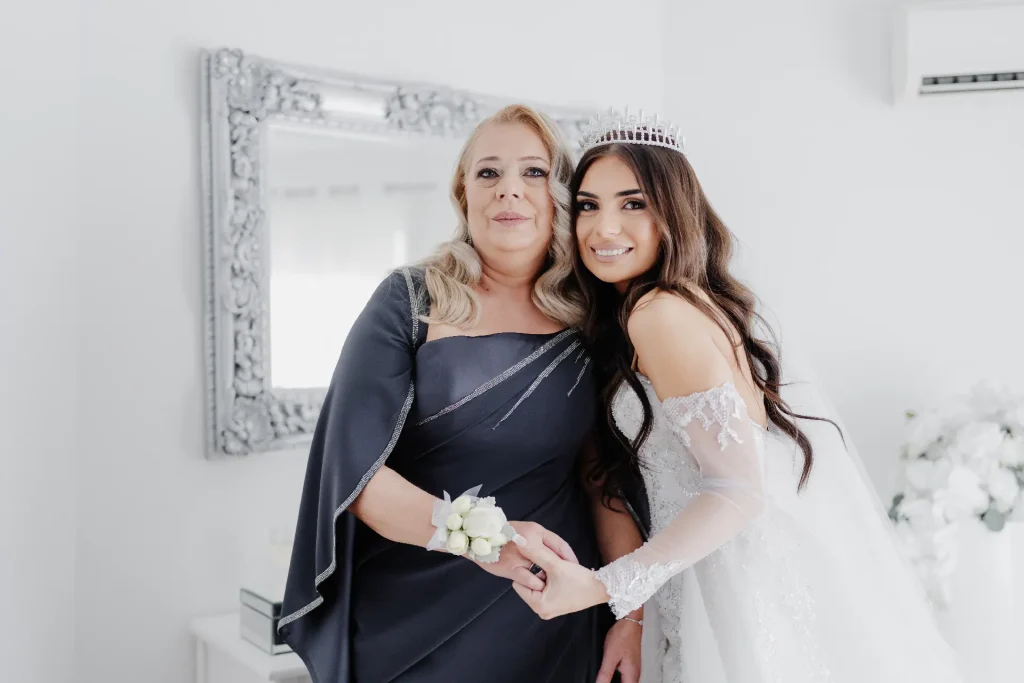Wedding traditions come in various forms and activities. Some prefer wearing cultural attire, some love doing a smoking ceremony, while others simply want to do some gestures that will respect their ancestral roots. One of the most popular on the list is the Macedonian wedding traditions and rituals.
Embark into the enchanting world of Macedonian Wedding Traditions and Rituals – where centuries-old customs intertwine with modern-day celebrations to create an unforgettable tapestry of love, romance, and joy. As you tie the knot, let us introduce you to the richness of Macedonian wedding traditions.
A Macedonian wedding is not merely a common event; it’s a rich and immersive experience showcasing the Balkan nation’s deep-rooted traditions. From unique rituals to lively celebrations, each component is meticulously crafted to honor the roots, unite families, and symbolize the beginning of a new chapter in your lives as a newly-wedded couple.
In this article, we invite you to journey with us on an exciting exploration of 10 remarkable Macedonian wedding traditions and rituals. We’ll uncover the symbolism behind the elaborate wedding attire, adorned with unique handcrafted details that reflect the cultural heritage of Macedonia.
1) Pre-Wedding Rituals: The Engagement
As you delve into Macedonian wedding traditions and rituals, let’s first explore the enchanting engagement ritual that ignites the start of your union. Prepare to blow your minds on a journey filled with cultural hype, heartfelt moments, and a touch of Macedonian ancestry.
In Macedonia, the engagement period is a much anticipated joyous time, where families celebrate the union of two souls. The traditional engagement ceremonies, known as “logovaški” and “badnik,” weave together customs and symbolism passed down through generations.
The “logovaški” ceremony signals the official announcement and celebration of the engagement. As the evening unfolds, the couple exchanges rings, sealing their commitment to one another. But wait, there’s more. There’s a surprising twist to this ceremony. In a playful gesture, the groom’s family presents the bride with a tray filled with various objects, each representing a different aspect of their future life together. These symbolic gifts carry hopes and blessings for their coming union.
As the engagement period progresses, the “badnik” ceremony takes place. This ritual holds deep religious significance, as it occurs on Christmas Eve. The couple is presented with ceremonial bread, known as “badnik.” This bread symbolizes the sharing of life’s sustenance and unity. Moreso, it’s a sacred moment that brings together faith, tradition, and a preview of their upcoming nuptials.
- The Wedding Flag and the “Barjaktar”
A vibrant flag dances in the air, carried with pride and joy by a figure known as the “baraka.” This captivating tradition, deeply rooted in Macedonian wedding customs, adds a touch of splendor and excitement to your much-awaited wedding day.
They believe that the wedding flag symbolizes unity and celebration, which holds a special place in Macedonian weddings. It’s a colorful banner that highlights the fun of the joyous occasion. Moreso, the flag represents the couple’s union as they step on a lifelong journey of togetherness.
Now, let’s turn our attention to the star of this tradition – the “baraka.” This role is bestowed upon a cherished individual, mostly a close friend or family member of the couple, who carries the honor and responsibility of the wedding flag. But the “baraka” role is not just about holding the flag. It’s about representing the bearer of the spirit of celebration and spreading joy throughout the festivities. This charismatic figure often leads the traditional Macedonian dance, known as the “oro,” inviting guests to join and create a lively atmosphere of laughter and pure bliss.
The wedding flag and the “baraka” infuse your special day with grandeur. They capture the essence of Macedonian wedding traditions, where every moment is infused with joy, love, and an unyielding preparation for a forever journey of life as a couple.
2) The Betrothal Bread: “Pastrmajlija”
Prepare to tantalize your taste buds and enjoy the culinary tradition that will leave your watery mouth craving. At this point, we will unravel the delicious story of the betrothal bread known as “Pastrmajlija.” Local says it’s a mouthwatering delight highlighting the rich heritage and love shared in Macedonian weddings.
In Macedonian weddings, the custom of baking and sharing betrothal bread, or “Pastrmajlija,” holds a special place. The aroma of freshly baked bread filling the air reflects the testament to the love poured while baking it. This traditional bread takes on various shapes, often resembling a boat or a heart, symbolizing the fantastic voyage of love and the union of two souls.
But this tasty treat is more than just bread; it symbolizes the bond the soon-to-be-wedded couple shares. When the betrothal bread is baked, it becomes a centerpiece of the celebration, expressing the desire for a fruitful and harmonious future for the couple. Take a bite of this culinary masterpiece, let the flavors entice your taste buds, and allow the betrothal bread to symbolize the beginning of your life as a couple.
- The “Gelina” Dance
Now, it’s time to lace up your dancing shoes and prepare for an unforgettable moment on the dance floor as we delve into the enchanting world of the “Gelina” dance. This dance is a captivating tradition that will sweep you off your feet and fill your heart with joy.
In Macedonian weddings, the “Gelina” dance is unique to the bride and her family. The beat of lively music fills the air, signaling the start of a dance that brings generations together, celebrating the union of two souls and the merging of two families.
As the bride gracefully takes to the dance floor, surrounded by her loved ones, an atmosphere of love spreads. This astounding dance captures the essence of the wedding celebration, encapsulating the joyous moments and creating perfect moments that will be cherished for a lifetime. In addition, the dance itself displays infectious energy and skillful footwork, accompanied by traditional Macedonian music that fills the air with an irresistible rhythm. If this doesn’t move you up on your feet, we don’t know what else will.
3) Shaving the Groom
Another time-honored ritual that marks the transition from bachelorhood to married life is the shaving of the groom. This is an excellent time for laughter and unforgettable memories as you unveil the heartfelt symbolism associated with this playful tradition.
In many cultures, including some Macedonian wedding celebrations, the act of shaving the groom holds special significance. It serves as a sign of the groom’s transformation from a reckless bachelor to a responsible spouse. As the shaving ritual unfolds, funny stories and experiences often come to the crowd. From crazy facial expressions to hilarious mishaps with shaving foam, the memories of this tradition always stay in the heart of the groom and his pals. Moreover, these light-hearted moments provide entertainment and help alleviate pre-wedding jitters, allowing the groom to relax and confidently embrace the joy of the upcoming special day.
May the act of shaving the groom fill your wedding day with laughter, camaraderie, and a sense of joyful anticipation for the adventures ahead. So, don’t hesitate to grab those razors, spread out the shaving cream, and let the funny memories commence together in this whimsical and meaningful tradition.
4) The Bride’s Veil
Delve into the mesmerizing beauty of the cherished tradition of choosing the bride’s veil. Explore its significance and the heartfelt moments unfolding as the veil symbolizes love, purity, and anticipation.
First, let’s discuss what the bride’s veil truly is. The bride’s veil is a fantastic accessory that adds an extra layer of covering to the bride’s attire. It’s a delicate and intricate piece of fabric that beautifully drapes over the bride’s head, covering her beautiful face and gracefully down her shoulders.
However, the bride’s veil is not just an extra accessory for the bride; it’s seen as a symbol of purity, modesty, and the bride’s transition into married life. It also serves as a gentle barrier between the bride and the world, highlighting the sacredness of the moment she unveils her captivating beauty to her beloved and all the witnesses of their union. With all the significance and tradition that the bride’s veil signifies, it’s great to say that choosing the perfect veil is a crucial aspect of wedding preparations. You can explore various styles, lengths, and embellishments, seeking the one that best reflects your personality and complements your bridal attire.

5) The Wedding Procession: “Svatba”
Unbeknownst to many, the “svatba” is not just a traditional procession; it’s a grand spectacle of love and togetherness that sets for soon-to-be-wedded couples like you. It’s a moment that brings together family, friends, and the entire community to celebrate your union.
As the traditional Macedonian music beats echo through the air, the “svatba” procession transforms into a vibrant tapestry of movement and merrymaking. The participants, dressed in colorful traditional attire, sway to the rhythm, their feet tapping in harmony, creating an atmosphere of pure happiness.
Needless to say, dancing becomes the language of celebration during the “svatba.” You’ll see yourself twirling with your partner as your friends link arms, and family members join the festivities. It’s a moment of pure exhilaration as the energy of the music infuses every step, lifting power and creating an uncontainable sense of joy.
6) The “Stapka na Baba” Ritual
Next on our list is the captivating “Stapka na Baba” ritual, where the bride takes a symbolic step onto a grandmother’s chest. In this unique ritual, the bride, with grace and reverence, places her foot upon the chest of a beloved grandmother or respected elderly woman. At first glance, this act might look bothersome. Still, it has a profound symbolism that speaks to the bond between two generations. The “Stapka na Baba” ritual is a testament to the bride’s recognition of the guidance and blessings bestowed upon her by her respected elders.
Moreover, this ritual represents a symbolic passage—a metaphorical step—into a new chapter of the bride’s life. It acknowledges the journey she is about to embark upon as she transitions from daughter to wife.
Furthermore, the “Stapka na Baba” ritual serves as a poignant reminder of honoring and cherishing our elders. It emphasizes the significance of respecting their valuable contributions to our lives and their role in shaping our identities.
7) The Coin Toss
In this endearing ritual, the newlyweds stand side by side, their hands interlocked, and toss the coins into the air. This Macedonian wedding tradition adds an extra sprinkle of excitement and good fortune to your special day.
The “Coin Toss” tradition comes from the belief that you are symbolically spreading the seeds of prosperity by scattering coins. Each coin represents a wish for financial growth, good fortune, and abundant married life. As the coins descend from the sky, some also believe that those who are present will also receive the blessing that comes with that tradition.
This tradition brings an electrifying energy to your wedding celebration, amplifying the joy and creating a shared moment of excitement and anticipation. The sounds of tinkling coins and the infectious laughter of your loved ones fill the air, signifying the start of a new chapter in your lives, brimming with prosperity and good fortune.
8) The “Makalo” Dinner
Of course, who wouldn’t want to include some fine meals as part of the Macedonian wedding tradition. Surrounded by the warmth of your loved ones, it is time to munch in on an intimate and joyous feast—the “Makalo” dinner.
The “Makalo” dinner holds a deep significance in the tradition, as it symbolizes celebrating your union and the coming together of families and friends. It’s a time to express gratitude for the love and support surrounding you throughout your journey as a couple until this momentous day. This feast will satisfy your hunger and nourish your soul as you bask in the positive energy of your loved ones and relish the flavors that connect you to your cultural roots.
May the flavors of the “Makalo” dinner fill your hearts with gratitude and contentment. As you gather around the table, let the laughter and unending stories flow, creating perfect moments that will be recalled for years.
Let Your Marriage Showered with Love and Joy With These Macedonian Wedding Traditions and Rituals
From the joyous engagement rituals of “logovaški” and “badnik,” where love is proclaimed, and blessings are bestowed, to the heartfelt moments of the “Angelina” dance and the symbolic act of stepping on a grandmother’s chest in the “Stapka na Baba” ritual, each tradition we unfold is a moment of pure joy, connection, and cultural significance.
Consider incorporating some of these remarkable Macedonian traditions into your wedding, whether it be a gesture of looking back to the past or an opportunity to forge new traditions that reflect your unique love story. Embrace the richness and beauty of Macedonian wedding traditions, and allow them to infuse your celebration with depth, meaning, and a sense of cultural heritage. And don’t forget to secure your wedding photography team to capture every joyous moment so you’ll have something to look back on in the years to come.
Cheers to love, cheers to tradition, and cheers to a future filled with blessing, prosperity, and vibrant customs.

Jeffrey Wang, a seasoned wedding expert with over a decade of experience, leads a thriving photography business. His team captures couples’ precious moments with a keen eye for detail and storytelling. Jeffrey’s work has been featured on prestigious platforms like Martha Stewart Weddings and Polka Dot Wedding.
Combining technical mastery with emotional understanding, Jeffrey creates a comfortable experience for couples, ensuring their personalities shine through in every image. His approach guarantees that cherished wedding memories are beautifully preserved for generations.














